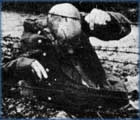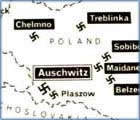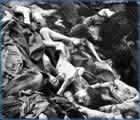| |
 |
| The Holocaust |
| |
|
| |

> Click to enlarge |
|
|
It is well known that six million
Jews died in the vast and complex series of events that have
come to be known as the Holocaust.
Today, nearly 60 years after the end of the Second World War,
the details, scope and significance of those events continue
to astonish those who attempt to understand what happened.
The Holocaust, certainly history’s most heavily documented
genocide,
is a focus for continuing attempts to understand issues of
hatred and genocide, both in history and the present. |
The Nazi government of Adolf Hitler devised a comprehensive
strategy to rid Europe of its entire population of Jews, first by
emigration and later by outright mass killing. They also targeted
broad groups of political opponents, including Communists, and other
groups they considered inferior, including Slavic peoples, the gypsies,
also called Roma, disabled people and homosexuals. But European
Jews, of whom two of every three perished, were their primary victims.
The foundations of the plan and the sometimes unwitting
complicity of much of the civilized world, including even democratic
governments and the Catholic church, are cloudier.
The harsh peace of the First World War imposed great
hardships on Germany through the 1920s and 1930s, creating the foundation
of discontent which Hitler and his co-conspirators were able to
manipulate and exploit. They created a system of propaganda
and legislation so overwhelming and pervasive that it helped to
convince a cultured nation that the source of its misery was its
Jewish population.
| |

> Click to enlarge |
|
|
After manipulating his way into
office as German chancellor in January 1933, Hitler created
a program of official antisemitism.
It quickly escalated from resentment to persecution then isolation
in ghettoes and finally mass murder in killing fields and
death camps. Children, men and women of all ages were killed
simply on the basis of their religious origin.
The Nazis created a myth of racial purity based on racist
hygiene, a belief that higher genes were dominant in Aryan
races such as Germans, lower genes in non-Aryan races such
as Jews and Slavs. Lower genes were perceived to be a threat
to society. The new concepts of this racial biology and the
centuries old antisemitism in Europe laid the foundation for
the Holocaust. |
They portrayed Jews as lazy, arrogant, usurious and
filthy criminals who undermined the purity of German culture and
Aryan blood. At the same time, the Nazis also considered Jews to
be powerful racial opponents with whom the Nordic races contended
for world domination. At the feet of the Jews the Nazis laid the
blame for unemployment, poverty and diminished stature on the world
stage.
Hitler and his associates offered a brainwashed public
a vision that would rescue them from the ignominy they had known
since being defeated in the 1914-1918 war. Much of the nation co-operated
and the rest of the world stood by as the program went into effect.
With scientific precision, the Nazis measured the
Jewish populations of Germany and its European neighbours, and before
the outbreak of the Second World War in 1939, the elimination of
German Jews was already well underway.
| |

> Click to enlarge |
|
|
The Nazis first destroyed the
Jewish professional and merchant classes with the Nuremberg
Laws -- “purity laws” passed to enforce a complete
separation between Aryans and non-Aryans, particularly Jews.
This was followed by the brutal Kristallnacht of 1938, when
synagogues were set on fire and Jewish businesses destroyed,
leaving German city sidewalks covered with shattered glass.
The Nazis established ghettoes, sealing Jews in cramped conditions
where disease and starvation advanced their multiple goals
of further demoralizing, weakening and reducing the population.
But this was merely a preview of worse atrocities that lay
ahead. |
Soon after attacking Czechoslovakia and Poland, the
Nazis began the transportation of tens of thousands of Jews to a
network of concentration camps where they began the first phases
of what they called the “final
solution” to the existence of European Jewry.
Perhaps two million died outside the camps — by
starvation and disease in ghettoes or at the hands of Einsatzgruppen,
or mobile killing squads. The remainder died in the camps, where
they were deliberately starved, worked to exhaustion, exposed to
disease, subjected to torture and bizarre medical experiments and
brutalized by guards. Many were shot and many more, numbering in
the millions, were killed in the infamous gas chambers. The Auschwitz-Birkenau
network of camps in Poland was by far the largest Nazi complex designed
for efficient mass murder. There, as in other death camps, hundreds
at a time were shaved, made to strip naked and ordered to sort their
own belongings into piles before being forced into sealed chambers
and fatally gassed. Their bodies were harvested of gold teeth and
fillings before they were burned in ovens or in open fires, filling
the air with the horrifying smell of their incineration.
| |

> Click to enlarge |
|
|
In the final months of the Second
World War, as German defeat became inevitable, the Nazis worked
desperately to complete their program of annihilation at the
same time as they scrambled to obliterate evidence of their
atrocities.
They deliberately blew up their gas chambers and tried to
eliminate surviving witnesses before the camps were liberated
and the war in Europe concluded in May 1945. But the post-war
trials at Nuremberg
finally and firmly established the catalogue of crimes that
the world struggles to comprehend even today. |
| |

> Click to enlarge |
|
|
Perhaps incredibly, a pernicious
undercurrent of denial continues to exist, powered by individuals
and groups who foster the idea that the Holocaust did not happen
or that it has been exaggerated. Their subversive efforts have
helped to foster renewed dedication among survivors, their descendants
and the public at large to educate everyone, and strive to assure
that the Holocaust is neither forgotten nor repeated. |
Back
to Top
|






